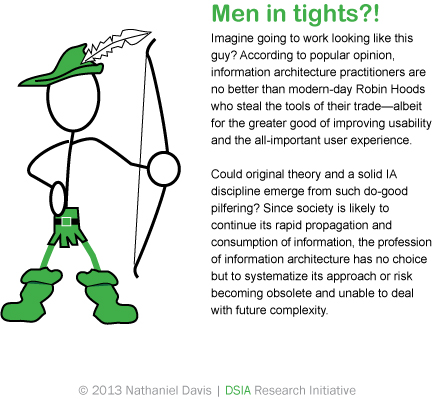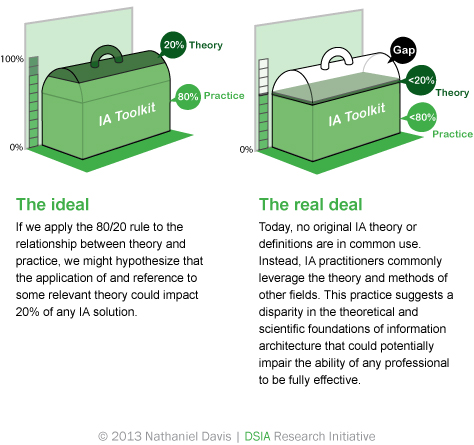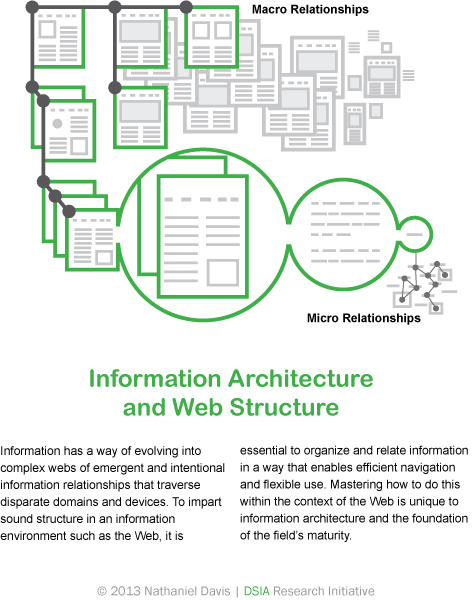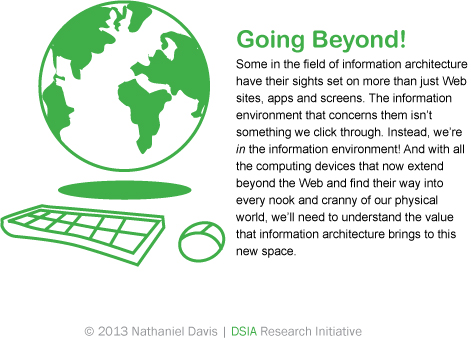What We Need
When you scan the Internet’s trove of content about information architecture, you’ll find that it is rich in practical insights. Methods and best practices help IA practitioners solve real-world problems—the sorts of practical problems that many of us confront on a daily basis.
Peter Morville and Lou Rosenfeld’s ground-breaking book, Information Architecture for the World Wide Web—also known as the polar bear book—brought a sense of practicality, as well as legitimacy, to information architecture by combining techniques of library science and building architecture to solve the challenges of complex Web sites. The authors were convinced of the value of taking such perspectives to improve the findability of information on the Web and the overall usability of computing interfaces. The second edition of their book canonized their ideas and offered approaches and examples that are as relevant today as they were when they were first introduced in 1998. In the third and final edition of the polar bear book, Morville and Rosenfeld described the scope of information architecture as:
- “the structural design of shared information environments”
- “the combination of organization, labeling, search, and navigation systems within Web sites and intranets”
- “the art and science of shaping information products and experiences to support usability and findability”
- “an emerging discipline and community of practice focused on bringing principles of design and architecture to the digital landscape”
The significance of Morville and Rosenfeld’s book on information architecture was that it provided practical knowledge. Within the context of information architecture, practicality lets us deal with the often opaque issues around the low-hanging fruit and immediate painpoints that we address when creating Web-based products, services, and ecosystems. By taking a practical and pragmatic approach, we can solve existing problems.
When you deliver solutions for existing problems, you offer business value. It is this level of applied practicality that has satisfied the urgent needs of the ever-expanding Web and helped to sustain the field of information architecture for almost two decades. However, despite the recognition that information architecture has received, Toon is one among a growing segment of IA professionals who feel that the information architecture toolkit is still insufficient to our needs.
Yes, practicality is important. But, since it inherently limits us to a type of professional empiricism that typically solves problems only as they arise, practicality offers, at best, perhaps 80% of what we actually need in most circumstances. The other 20% of professional competency comes from theory. The problem is that information architecture is maturing primarily through ad hoc theory and practice. [1]
It’s like having to put a piece of furniture together that requires a screwdriver, a wrench, and a pair of pliers when all you have is a screwdriver, pliers, and a sledgehammer. You eventually discover that mechanics use the type of wrench you need, so you buy the wrench and add it to your toolkit. Many view the profession of information architecture—or craft, as some would argue—in a similar manner; as a profession that steals tools from other disciplines as a maturation strategy.![]()
To advance beyond the practice of stealing as the primary approach to building a professional toolkit, which I’ve represented in Figure 1, we need more theory.

A Lot of Theory
While we might not need “a lot of theory,” as Toon suggests, we do at least need the right theories to help practitioners solve the unanticipated challenges that we’ll encounter in the future. I think this is what Toon was getting at. But, whether we need just a few theories or an arsenal of them, the fact remains that, at best, anyone currently practicing information architecture is doing so with an insufficient toolkit, as Figure 2 illustrates.
Those who consciously avoid academic conversations about theory might not see the urgency in our need to address such topics. Their interests focus on the practical, time-constrained needs of their company or clients. These professionals improve the way people navigate through sets of information—whether small or dense—and recommend effective content organization schemes. They create formal taxonomies, domain models, and structured content and are digging into the emerging challenges of cross-channel and cross-media engagement.
But, let’s face it. Have you ever asked yourself: What formal theory or scientific thinking is really holding all of this IA stuff together? What makes an information architecture an architecture for information? What is the information, and what is the architecture? Do these two words even mean anything to you? If they do, how do they influence your approach to your IA practice?
Theory begins, in part, with definition and ends by drawing a proverbial, epistemic line in the sand to which practitioners can refer for guidance—if not answers. Today, respectfully, even the most valued writings on information architecture provide practical guidance, at best.
If there is one thing that our profession must get right, it is our obligation to establish and propagate actionable definitions that we substantiate through intentional practice and sound theory. Together, they’ll promote the science that we need to implement information architectures with confidence.



